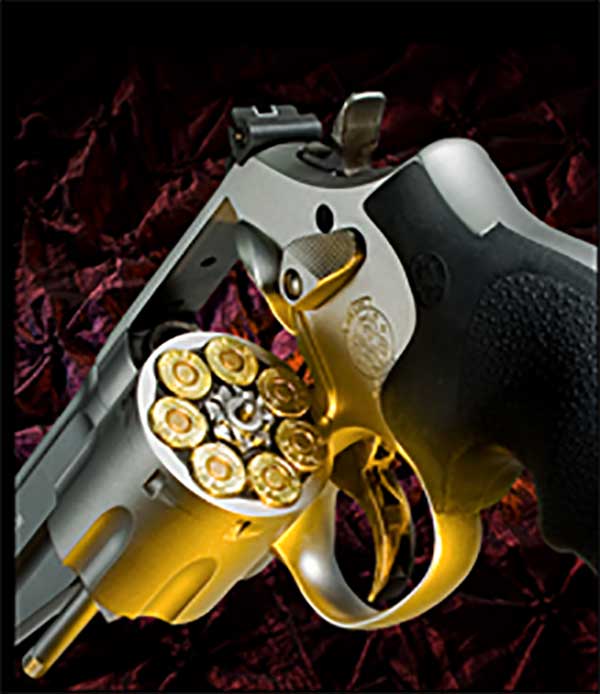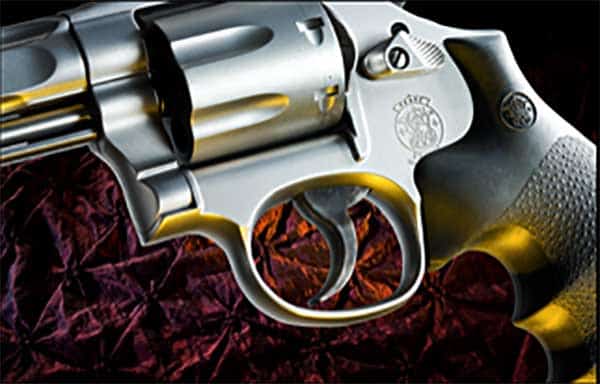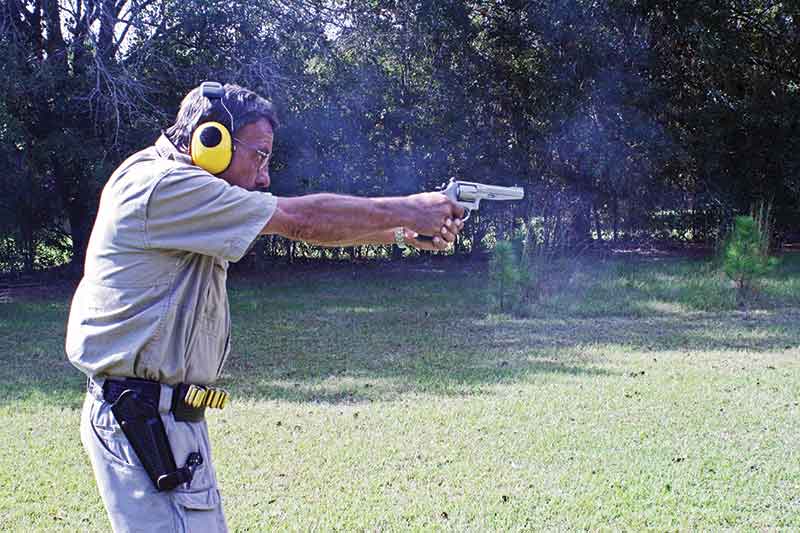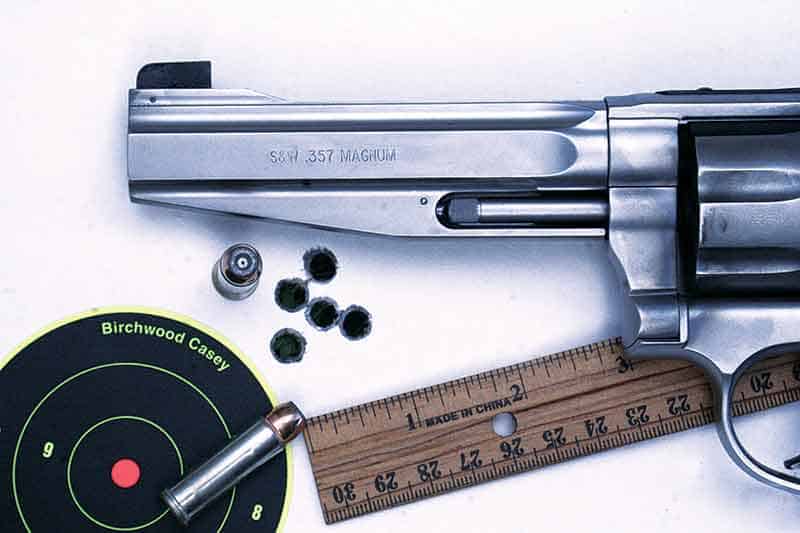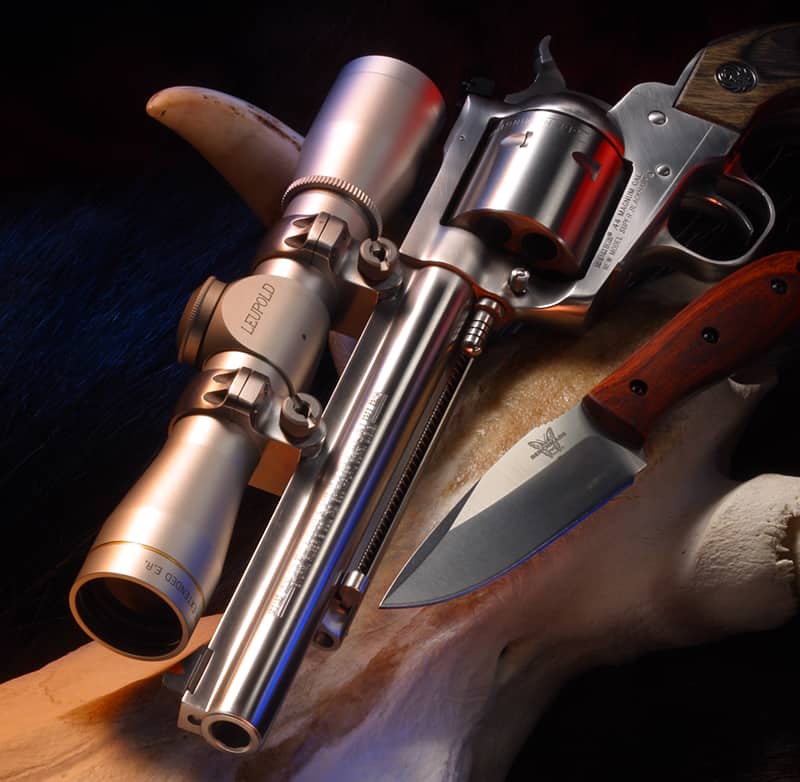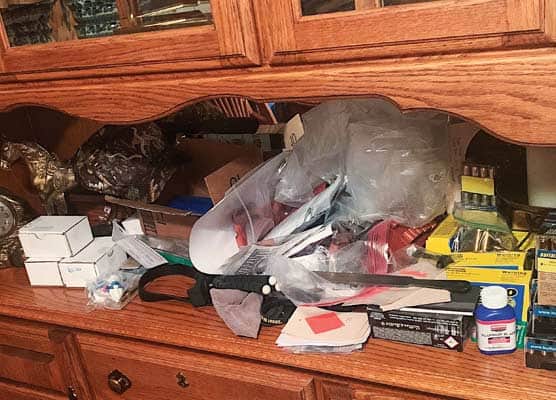Lucky 7
A 686 + .357 Magnum From S&W's "Pro Series"
There are three grades of shootability in the shootin’ irons available from Smith & Wesson. The standard production grade has set a standard of excellence in the handgun industry worldwide since 1856. At the other end of the scale are the guns from S&W’s Performance Center; very much like similarly named sections in the auto industry. The Center turns out special purpose racing iron, some of which gets raced at the national and world championship level, and some of which goes to connoisseurs of those particular machines who can afford to pay for the absolute best.
In this economy more than ever, there are folks who appreciate performance, but just aren’t budgeted for top dollar right now. GUNS Magazine knows that… and so does Smith & Wesson. That’s why, a few years ago, S&W introduced its Pro Series. These are handguns conceptualized and tested in the Performance Center then turned over to the regular Production side of the house, allowing more affordable pricing.
At the time the cover gun was sent to us, it was so new the company hadn’t assigned it a stock number, and it came in a box marked “Model 686” and “4″ barrel.”
Well, it wasn’t. This specimen, serial number CML1430, is stamped “686-6” (the “-6” denoting the presence of the internal locking system). It is actually a Model 686-Plus, meaning an L-frame .357 Magnum with 7-shot cylinder. The barrel is 5″ long, and shaped in the manner of the company’s popular 686 SSR, another revolver in the Pro Series.
Jim Unger, head of revolver production at S&W, calls this configuration the “wedge barrel.” Tony Miele, head of the Performance Center, describes it as the “tapered barrel.”
I can’t argue with either one of them. It is wedge-shaped, and it is tapered. Seen from above, the flat-sided barrel narrows a bit, a little more than 1/2″ in front of the frame, and then continues in slim, straight lines to the muzzle. Seen from the side, the ejector rod shield is open on both sides, in the SSR style, and what might be called a “half underlug” sweeps up toward the muzzle, growing narrower along the way. This shape may help to reduce friction drag as the gun is being drawn from the holster. It definitely allows smoother, easier re-holstering, which admittedly is more of a tactical concern than a competition concern, and this sweet 7-shooter seems to have “competition” written all over it.
The SSR is named for the Stock Service Revolver division in IDPA, the International Defensive Pistol Association. Because IDPA limits shooters to 6 rounds in their revolvers, the 686 SSR has the conventional 6-chambered cylinder. Says Tony Miele, “We had experienced very good success with the 686 SSR within the IDPA community. The 5″ gun is a natural follow-on for ICORE shooters, who can have longer barrels and who can take advantage of the 7th shot.”
ICORE is the International Congress Of Revolver Enthusiasts. Their formats seem a bit like the Steel Challenge, where a lighter-barreled revolver is an advantage because it swings faster between the multiple targets. Miele knows the ICORE game, and it sounds as if the new gun will be a fine candidate for it.
A couple of other Performance Center touches adorn this Pro Series gun. The cylinder face is cut for full moon clips, the fastest possible reloading system for a wheelgun. The chambers also appear to have been chamfered at the factory, to further enhance reloading speed. The action is not hand-honed like a true Performance Center gun, but this one does have the lighter mainspring the Performance Center uses on its custom L-frames.
The .357 is of course one of our most versatile chamberings, which adds to this gun’s desirability. I took the 686-6 to the 25-yard bench with an MTM pistol rest and five loads ranging from mouse-fart to Magnum. They’re presented in alphabetical order. Each 5-shot group was measured once overall as an indicator of what it and the gun could do from a solid position in experienced but fallible human hands, and once again for the best 3-shot cluster. Experience and testing have taught me this latter mechanism will give a very close prediction of what the same gun/ammo combination is likely to do for all five shots from a machine rest. All measurements were taken to the nearest .05″.
American Eagle, Federal’s economy line, has a version of the popular 130-grain full metal jacket .38 Special “Air Force bullet,” popular because it’s cheap, and may be the best of its kind in speed-driven competitions when allowed because it’s a roundnose instead of flat at the tip. This allows it to speedload a little quicker. This is normally an accurate load. The week before the test, my girlfriend won a match with it out of her Bill Pfeil-customized S&W Model 67 4″. This new S&W didn’t like it at all. Although it was OK at 7 yards, at 25 it patterned more than grouped. I can’t imagine why, but guns are like us: they seem to have their own, sometimes picky, preferences.
Black Hills manufactured two of our test loads, both light .38 Specials. Their 148-grain mid-range wadcutter cut five easy-to-see holes measuring 1.65″ apart. The best three were under an inch, to wit, .95″. The other Black Hills product we used was their cowboy load, which uses a truncated cone shaped 158-grain bullet, all lead like the wadcutter, at a moderate velocity. This actually shot tighter than the wadcutter, with a 1.35″ overall group and the best three only .90″ apart.
Top Load Is A Handload
A handload was next, put together by outdoor writer and pistol champ Chris Christian. Comprising a semi-jacketed Speer 140-grain hollowpoint in a .38 Special case over 6.1 grains of Hodgdon Longshot and a Federal small pistol primer, it was running fast enough to make IDPA’s requisite 125,000 power factor (determined by velocity in feet per second multiplied by bullet weight in grains), this fine example of the handloader’s art gave the best accuracy of the test. All five shots were well under an inch, measuring .85″ center to center. The best three measured .45″: a single .45 caliber hole would have bisected them all! You just can’t ask for better accuracy than that from a production revolver.
Moving up the power scale, we used a .357 Magnum round at the end. It was Winchester’s street-proven 145-grain Silvertip. This opened up slightly, delivering a 2.45″, but the best three were still under an inch: 0.95″.
Now, let’s look at that for a moment. There was one load out of five the test gun just didn’t group with. Setting it aside, the other four were all under 2-1/2″ for the 5-shot, hand-held group, and three of those four were under 2″, and one well under 1″. The “best three” measurements, indicative of inherent mechanical accuracy potential, were all under 1″ and one was under 1/2″. That, my friends, is accuracy with which you can win most any kind of handgun match.
When an outdoor writer tests a new deer rifle, he hunts deer with it and does his darndest to shoot one. It would seem the best way to test a handgun born for competition, would be to shoot a match with it. I therefore set out looking for one. I had already put together an eclectic black basketweave rig for it: Bianchi dress gunbelt, Safariland synthetic 021 competition holster, and a poor man’s moon clip carrier: a Don Hume cartridge slide. I was, b’gawd, ready to shoot.
Matchless
Tony Miele had designed this model with ICORE in mind, and I called a club an hour and a half away known to put those on. I discovered they had dropped ICORE a year before. There wasn’t another in striking distance. Dang!
Bowling pin shooting is another venue where a 7th shot is a benefit. I checked the calendar. The next one within reasonable driving distance would be after deadline. Double dang!
NRA Action Pistol, as typified by the Bianchi Cup, is fired in 6-shot sequences but the wheelgunner there can certainly benefit from a 7th round in reserve. But there was no NRA Action Pistol match anywhere near me, either. IDPA? The 5″ barrel was 1″ too long for the rules to allow. PPC? There was only one PPC event on the schedule, and that was a Service Revolver match in Tallahassee, run in accordance with NRA rules, which mandate a 4″ maximum barrel length. I had to be there to teach that week anyway.
I was “all gunned up with nowhere to go.” So that was that, skunked for any chance to shoot the thing in a match, I took the test gun to my own range and set up a couple of match courses with it, two days before deadline for this article. First, I set up a B-27 NRA police silhouette target. The Service Revolver course is comprised of 48 rounds. Six shots 1-handed in 8 seconds at 3 yards proved the revolver handled well in a single paw, but I hadn’t quite sighted it in perfectly yet and the group was in the upper right of the X-ring.
The second stage is draw, fire six, reload, and fire six more, all in 20 seconds from 7 yards. Two handed and holding at 7 o’clock in the X-ring, the smooth Smith made it easy to “clear” this stage, also. The third stage is the same as the second but at 15 yards, and here I got careless and held the sights too far left, and dropped my first point, a 9-ring hit. The match finishes with a draw and six shots each kneeling, standing left hand barricade, and standing right hand barricade, in 90 seconds including reloads. The gun did well in the left hand for an out of the box double action with the non-dominant hand controlling, the way this match must be shot. I finished with the same point score I’d won the Service Revolver match with a week before in Tallahassee.
For a first time over the course, that spoke well for the test gun. Yes, it had adjustable sights, but I had failed to adjust them correctly. Yes, it had a good action for out of the box, but not as good as the well-worn-in Model 64 I’d shot before, whose sights were dead on. Getting the same score under these circumstances tells me this gun is capable of better scores with familiarization and perfect sighting in, and is clearly capable of perfect scores, even national record scores, in this type of shooting.
With none of the tombstone-shaped Bianchi Cup targets on hand, there was only one NRA Action Pistol event I could duplicate on short notice, the Bianchi Plates. A rack of 8″ diameter falling plates, six of ’em, is shot twice each from 10, 15, 20, and 25 yards. Back when I shot the Cup, ’79 through ’88, the times were six, seven, eight, and nine seconds respectively per string, so that’s what I set the timer for.
The 5″ 686 came up smoothly out of the Safariland holster, even though it was made for a 6″ gun, and allowed me to easily clean two-dozen plates at 10 and 15 yards. On the 20-yard line, I got froggy on the trigger and missed a plate. (I dropped it anyway with the 7th shot, “just because,” but it still counted as a miss because NRA rules say you can only take one shot at each plate. In NRA Action Pistol, the big advantage of this gun’s 7th chamber is you can fire it to make up for a misfire or a skipped chamber.) At 25 yards I missed another, and finished the course with a 460 out of 480 possible. Well, I don’t remember ever getting a perfect score on the plate stage at Bianchi Cup, either.
I wasn’t testing me, though, I was testing the gun—and this 7-shot 5″ passed with flying colors. For those who prefer a revolver, it should also make a neat home defense gun. Recoil wasn’t bad at all with the factory-provided Hogue grips even with .357 Magnum rounds, and one more bullet never hurts. Besides, there are lots of folks who, like the late, great Skeeter Skelton, believe a 5″ barrel is just the right compromise length for a heavy-duty service revolver.
There was only one misfire during the almost 300 rounds I managed to put through this revolver in the midst of the Great Post-Obama Ammo Drought, and that was from an ancient box of 158-grain .38 Special. (How long ago did they stop making S&W brand ammo, anyway?) If nothing else, it was the perfect reminder of what that 7th chamber is for. Kinda like the gun itself: “better to have it and not need it, than need it and not have it.” I’m glad to see Tony, Jim, and the whole team at Smith & Wesson are still working to give us more options that reflect sound engineering, quality manufacturing and, in this case, creative thinking.
MODEL 686+ PRO SERIES
MAKER: S&W
2100 Roosevelt Avenue
Springfield, MA 01104
(800) 331-0852
https://www.smith-wesson.com
Action type: Double action revolver
Caliber: .357 Magnum
Capacity : 7
Barrel length: 5″
Overall length: 10″
Weight: 37.5 ounces
Finish: Stainless steel
Sights: Patridge front, fully
adjustable rear
Grips: Hogue monogrip
Price: $1,059


